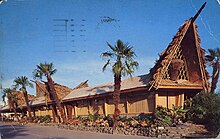In MÄori mythology, Tiki is the first man, created by either TÅ«matauenga or TÄne. He found the first woman, Marikoriko, in a pond; she seduced him and he became the father of Hine-kau-ataata. By extension, a tiki is a large wooden carving in humanoid form, although this is a somewhat archaic usage in the MÄori language. Carvings similar to tikis are found in most Central Eastern Polynesian cultures. They often serve to mark the boundaries of sacred or significant sites.
Religion

In traditions from the West Coast of the South Island of New Zealand, the first human is a woman created by TÄne, god of forests and of birds. Usually her name is Hine-ahu-one. In other legends, TÄne makes the first man Tiki, then makes a wife for him. In some West Coast versions, Tiki himself, as a son of Rangi and Papa, creates the first human by mixing his own blood with clay, and TÄne then makes the first woman. Sometimes TÅ«matauenga, the war god, creates Tiki. In another story the first woman is MÄrikoriko. Tiki marries her and their daughter is Hine-kau-ataata (White 1887-1891, I:151-152). In some traditions, Tiki is the penis of TÄne (Orbell 1998:178, Tregear 1891:510-511). In fact, Tiki is strongly associated with the origin of the procreative act.
In one story of Tiki among the many variants, Tiki was lonely and craved company. One day, seeing his reflection in a pool, he thought he had found a companion, and dived into the pool to seize it. The image shattered and Tiki was disappointed. He fell asleep and when he awoke he saw the reflection again. He covered the pool with earth and it gave birth to a woman. Tiki lived with her in innocence, until one day the woman was excited by an eel. Her excitement passed to Tiki and the first procreative act resulted (Reed 1963:52).
Names and epithets
John White names several Tiki or perhaps manifestations of Tiki in MÄori tradition (White 1887-1891, I:142):
- Tiki-tohua, the progenitor of birds
- Tiki-kapakapa, the progenitor of fish and of a bird, the tui
- Tiki-auaha, the progenitor of humankind
- Tiki-whakaeaea, the progenitor of the kūmara.
Elsewhere in Polynesia
The word appears as tiki in New Zealand MÄori, Cook Islands MÄori, Tuamotuan, and Marquesan; as tiÊ»i in Tahitian, and as kiÊ»i in Hawaiian. The word has not been recorded from the languages of Western Polynesia or of Rapanui (Easter Island).
- In Hawaiian traditions the first man was Kumuhonua. He was made by KÄne, or by KÄne, KÅ«, and Lono. His body was made by mixing red earth with saliva. He was made in the shape of KÄne, who carried the earth from which the man was made from the four corners of the world. A woman was made from one of his ribs. Kanaloa was watching when KÄne made the first man, and he too made a man, but could not bring him to life. Kanaloa then said to KÄne, “I will take your man, and he will die.†And so death came upon mankind (Tregear 1891:151).
- In Tahiti, Tiʻi was the first man, and was made from red earth. The first woman was Ivi who was made from one of the bones (ivi) of Tiʻi (Tregear 1891:151) .
- In the Marquesas there are various accounts. In one legend Atea and his wife created people. In another tradition Atanua and her father Atea brought forth human beings (Tregear 1891:151).
- In the Cook Islands, traditions also vary. At Rarotonga, Tiki is the guardian of the entrance to Avaiki, the underworld. Offerings were made to him as gifts for the departing soul of someone who is dying. At Mangaia, Tiki is a woman, the sister of Veetini, the first person to die a natural death. The entrance to Avaiki (the underworld) is called ‘the chasm of Tiki’ (Tregear 1891:151).
- According to Easter Island (Rapa Nui) legend, Hotu Matu'a, the first chief brought along a moai (other traditional sources mention two) symbolizing ancestors, which became the model for the large moai. Dr. Jo Anne Van Tilburg of the Easter Island Statue Project at UCLA, says that the first stone statues originated on Rapa Nui, although oral traditions do not support this and hers is just an opinion. Others contend that the first statues originated in the Marquesas or Austral Islands in present day Tahiti (French Polynesia).
See also

- Hei-tiki, MÄori neck pendants, often called tiki
- Moai, a monolithic human figure on Easter Island, sometimes erroneously called tiki
- Olmec colossal heads, stone heads from the Olmec civilization
- Tiki culture, a 20th-century kitsch decorative style used in Polynesian-themed restaurants
- Totem pole, artworks similar in shape and purpose from Cascadian cultures
- Chemamull, Mapuche statues
Notes

References


